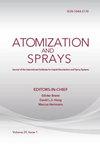跨临界蒸发在控制两相混合向单相混合过渡中的作用
IF 0.9
4区 工程技术
Q4 ENGINEERING, CHEMICAL
引用次数: 0
摘要
通过近临界单液滴的动力学研究,可以在明确定义的条件下研究从两相混合到单相混合的过渡,避免了因液滴间相互作用和燃烧而产生的额外复杂性。最近,有人提出了一种经验制度图来预测微观跨临界液滴的演变。实验表明,相对于蒸发流体的临界点,在很宽的超临界环境压力和温度范围内,经典蒸发仍然是控制机制。此外,过渡到单相混合的起始环境压力与温度成反比变化。为了解释这一趋势,我们通过杨最初提出的朗缪尔型蒸发模型,从理论上研究了单个液滴在近临界条件下的行为。由于在汽液界面附近加入了气体动力学效应,该模型包含了一个经过修改的边界条件。利用这一先进的蒸发模型分析再现了上述体系图,显示出与实验结果的良好一致性。分析还显示,单相混合体系的出现与蒸发过程的淬火有关。后者是由蒸发系数的降低引起的,而蒸发系数控制着穿过克努森层的传质速率。蒸发冷却的减少导致液滴迅速升温,材料界面在临界温度下解体。本文章由计算机程序翻译,如有差异,请以英文原文为准。
On the role of trancritical evaporation in controlling the transition from two-phase to single-phase mixing
The dynamics of near-critical single droplets allows to investigate the transition from two-phase to single-phase mixing under well-defined conditions, devoid of the additional complications due to drop-drop interactions and combustion. Recently, an empirical regime map was proposed
to predict the evolution of microscopic transcritical droplets. The experiments show that classical evaporation remains the controlling mechanism over a wide range of supercritical ambient pressures and temperatures with respect to the critical point of the evaporating fluid. Moreover, the onset ambient pressure for the transition to single-phase mixing varies inversely with temperature. To explain this trend, the behavior of a single droplet at near-critical conditions is investigated theoretically by means of a Langmuir-type evaporation model, originally proposed by Young. The model incorporates a modified boundary condition due to the inclusion of gas kinetic effects close to the vapor-liquid interface. This advanced evaporation model is employed to reproduce analytically the above-mentioned regime map, showing a good agreement with experimental findings. The analysis also revealed that the onset of the single-phase mixing regime is associated to the quenching of the evaporation process. The latter is caused by the decrease of the evaporation coefficients, which control the mass transfer rate across the Knudsen layer. The resulting reduction in evaporative cooling leads to the rapid heating of the liquid droplet and to the disintegration of the material interface at the critical temperature.
求助全文
通过发布文献求助,成功后即可免费获取论文全文。
去求助
来源期刊

Atomization and Sprays
工程技术-材料科学:综合
CiteScore
2.10
自引率
16.70%
发文量
54
审稿时长
1.7 months
期刊介绍:
The application and utilization of sprays is not new, and in modern society, it is extensive enough that almost every industry and household uses some form of sprays. What is new is an increasing scientific interest in atomization - the need to understand the physical structure of liquids under conditions of higher shear rates and interaction with gaseous flow. This need is being met with the publication of Atomization and Sprays, an authoritative, international journal presenting high quality research, applications, and review papers.
 求助内容:
求助内容: 应助结果提醒方式:
应助结果提醒方式:


